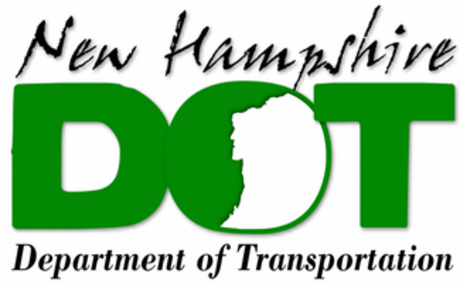The New Hampshire Department of Transportation (NHDOT) is a government agency of the U.S. state of New Hampshire. The Commissioner of NHDOT is Victoria Sheehan.[1] The main office of the NHDOT is located in the J. O. Morton Building in Concord.
This article needs additional citations for verification. (January 2009) |
 | |
| Agency overview | |
|---|---|
| Formed | 1986 |
| Preceding agencies |
|
| Jurisdiction | New Hampshire |
| Headquarters | 7 Hazen Drive Concord, New Hampshire |
| Agency executive |
|
| Website | www |
Functions
NHDOT's general functions, as provided in NH RSA:21-L, are:
- Planning, developing, and maintaining a state transportation network which will provide for safe and convenient movement of people and goods throughout the state by means of a system of highways and railroads, air service, mass transit and other practicable modes of transportation in order to support state growth and economic development and promote the general welfare of the citizens of the state.
- Developing and maintaining state owned land and buildings, except as otherwise provided by law, and cooperating with the New Hampshire Department of Administrative Services in preparing a long-range state capital improvements plan.
- Performing any regulation of transportation activities required by law which is not within the jurisdiction of another state agency.
NHDOT operates a 5-1-1 traveler information system online and by phone.
NHDOT shares responsibility with the New Hampshire Division of Historical Resources (DHR) for the New Hampshire historical markers program.[2]
History

From 1905 to 1915, the responsibility for highways and bridges was vested with the State Engineer. From 1915 to 1950, the NHDOT was the "Division to the Highway Department", which was established under Chapter 103 of the New Hampshire Laws of 1915. In 1950, the department became the "New Hampshire Department of Public Works and Highways", established under Part 9 of Chapter 5 of the New Hampshire Laws of 1950.
On February 18, 1986, the Department of Public Works and Highways was reorganized under Chapter 402 of the laws of 1985 (RSA:21-L), as the Department of Transportation. This reorganization of the department added the Transportation Division of the Public Utilities Commission (Bureaus of Rail Safety and Common Carriers) and the Aeronautics Commission.
Additional agency reorganization under Chapter 257 of the New Hampshire Laws of 2004 changed the Division of Aeronautics to the Division of Aeronautics, Rail, and Transit.
Divisions
Under the 1986 reorganization plan, five divisions were created within the department:
- Project Development: Plans and designs transportation projects and oversees their construction
- Operations: NHDOT's largest Division is responsible for the maintenance of state highways and bridges, and the maintenance and operation of the State's turnpike system
- Administration: Responsible for support activities in the Department, including accounting, auditing, purchasing, budgeting, contracts, information technology and the print shop
- Division of Aeronautics, Rail and Transit: Works with Federal, state and local agencies to preserve and promote various modes of transportation outside of the mode of automobile/truck and highways
Defunct divisions
The New Hampshire Rail Transit Authority (NHRTA) was a short lived administrative agency attached to the NHDOT which was created in 2007 to oversee the development of commuter rail and other passenger rail service in New Hampshire.[3][4] The initial focus of the NHRTA was to provide oversight for the proposed Capitol Corridor intercity rail project (not to be confused with Amtrak's Capitol Corridor service in California), which would have connected Concord, New Hampshire, with Boston, Massachusetts, via Manchester and Nashua and the existing MBTA Commuter Rail Lowell Line, and also include a stop at Manchester-Boston Regional Airport.
The agency would prove to be extraneous; by 2010, constant political opposition and funding issues would hamper all NHRTA rail projects.[5] By 2019 the group had ceased to meet, and their website URL had lapsed. By 2022, development on the Capitol Corridor project has largely stalled.[6] Since then, the NHDOT Division of Aeronautics, Rail and Transit has overseen all rail projects within the state.
Regional planning
NHDOT shares planning authority with the following Metropolitan Planning Organizations and Regional Planning Commissions,[7] which allocate federal funding:
- Central New Hampshire Regional Planning Commission
- Lakes Region Planning Commission
- Nashua Regional Planning Commission
- North Country Council
- Rockingham Planning Commission
- Southern New Hampshire Planning Commission
- Southwest Region Planning Commission
- Strafford Regional Planning Commission
- Upper Valley-Lake Sunapee Regional Planning Commission
References
See also
External links
Wikiwand in your browser!
Seamless Wikipedia browsing. On steroids.
Every time you click a link to Wikipedia, Wiktionary or Wikiquote in your browser's search results, it will show the modern Wikiwand interface.
Wikiwand extension is a five stars, simple, with minimum permission required to keep your browsing private, safe and transparent.
